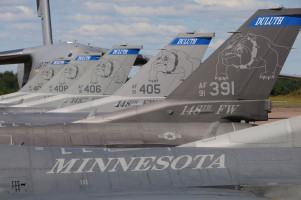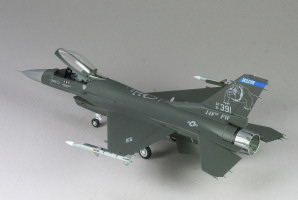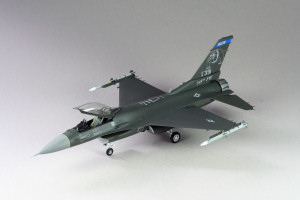
Tamiya 1/72 F-16CJ Block 50 Fighting Falcon Build Review
By Chuck Holte
| Date of Review | October 2014 | Manufacturer | Tamiya |
|---|---|---|---|
| Subject | F-16CJ Block 50 Fighting Falcon | Scale | 1/72 |
| Kit Number | 60786 | Primary Media | Styrene, Eduard PE #73508, Caracal Decals #72019 |
| Pros | Well molded, good fit, good background data and decals | Cons | Lack of pylons, external fuel tanks and pods |
| Skill Level | Basic | MSRP (USD) | $35.95 |
Background
The Lockheed Martin F-16 Fighting Falcon, better known as the "Viper," first flew as the General Dynamics YF-16 development/test aircraft in January 1974. Designed as an inexpensive (relatively), lightweight, single-engine, air superiority day fighter, it has evolved over the past 40 years into a formidable multi-role combat aircraft equipping the US and 25 other Air Forces worldwide. According to some Pentagon plans, Vipers will likely continue to serve the USAF until replaced entirely by F-35 Lightnings in 2025.
The F-16CJ Block 50 Viper in my build review is assigned to the 148th Fighter Wing (Call Sign: "Bulldog"), Minnesota Air National Guard (MNANG), Duluth International Airport, Minnesota. 148th Fighter Wing (Call Sign: "Bulldog"), Minnesota Air National Guard (MNANG), Duluth International Airport, Minnesota.
Construction
The recently released Tamiya 1/72 scale F-16CJ represents a Block 50 aircraft with a General Electric F110-GE-29 engine and the "Large Mouth" engine air inlet system. Upon opening the box lid, it was apparent Tamiya had done their homework and produced another fine offering. With an eight-page illustrated instruction sheet, a four-page painting and markings guide and a six-page illustrated, multi-lingual history and background paper, it has to be one of the more informed and accurate Viper kits available.
Six dark gray runners and one clear runner are done in finely molded styrene with excellent, in-scale, surface detail. Decals are provided for three aircraft: Tail Code "WW," the 5th Air Force Commander's aircraft from Masawa AB Japan; Tail Code "SP," 52nd Fighter Wing Commander, Spangdahlem AB Germany; and Tail Code "SW," a 2001 Tiger Meet of the Americas aircraft from the 79th Fighter Squadron, 20th Fighter Wing, Shaw AFB, South Carolina. The 4x6 inch decal sheet is in register and tightly packed with color markings for any one of the three aircraft. It also contains markings for the two kit provided AIM-120C AMRAAMs and the two AIM-9M Sidewinders. Oddly, the sheet also provides decals for an ECM Pod, AIM-9X Sidewinders, HARM Targeting Pod, AGM-88 HARMs, three external fuel tanks and a SNIPER XR Pod, none of which are provided for in the kit parts.
The model build took shape in the usual manner, starting with the cockpit and joining the forward upper fuselage with the aft upper fuselage, a hint that a two-seat version may be in the offing. I had the Eduard PE #73508 at hand and used it in place of painting the molded cockpit detail and to improve the kit ejection seat. To my taste, the kit's main landing gear bay and gear itself are well detailed and accurate and really didn't need help from the Eduard set, so those PE bits were not used.
Moving on to the engine air inlet; In my mind it was more complicated than necessary, but possibly done to accommodate variations for a Small Mouth inlet in future production runs. The kit inlet assembly required five parts and resulted in several untidy seams inside the inlet requiring a bit of work to make pretty (I didn't bother as I plan to use the Eduard inlet cover to hide it all). Other than the inlet, the overall engineering and fit of all the parts is excellent. Very little filling was required, that limited to the area where the radome and the optional part for the Advanced Identification Friend or Foe (AIFF) antennas, also known as the "Bird Slicers," meet forward of the canopy.
I chose not to use the kit decals. I already had the Caracal Models sheet "Vipers – The Next Generation" #72019, which included a MNANG Block 50aircraft in the new 5th generation "Have Glass" scheme and a big, badass Bulldog on the tail. Caracal suggests Humbrol 224 (Dark Slate Gray) as the FS36170 color for Have Glass. I airbrushed the model with the Humbrol 224, but it looked to light compared to photo references. Back to the paint shop, I added Model Master Interior Black and a few drops of MM Aluminum to the Humbrol until I was satisfied with a darker mix. I'm not completely happy with the final color, but to my old eyes, it's close enough to the photos for this model.
Conclusion
Overall, I enjoyed my first build of this new state-of-the-art kit from Tamiya. Excellent detail throughout and modeler-friendly things like positive positioning tabs for landing gear doors and the canopy make it a contender for the Best Viper kit in 1/72. On the down side, I was disappointed at the lack of pylons, external fuel tanks and pods, which, in my mind, leave the Viper looking only partially dressed. In spite of my whining about more underwing stores, I highly recommend the kit and hope Tamiya continues the 1/72 Vipers series with earlier production Blocks and two-seat versions.














